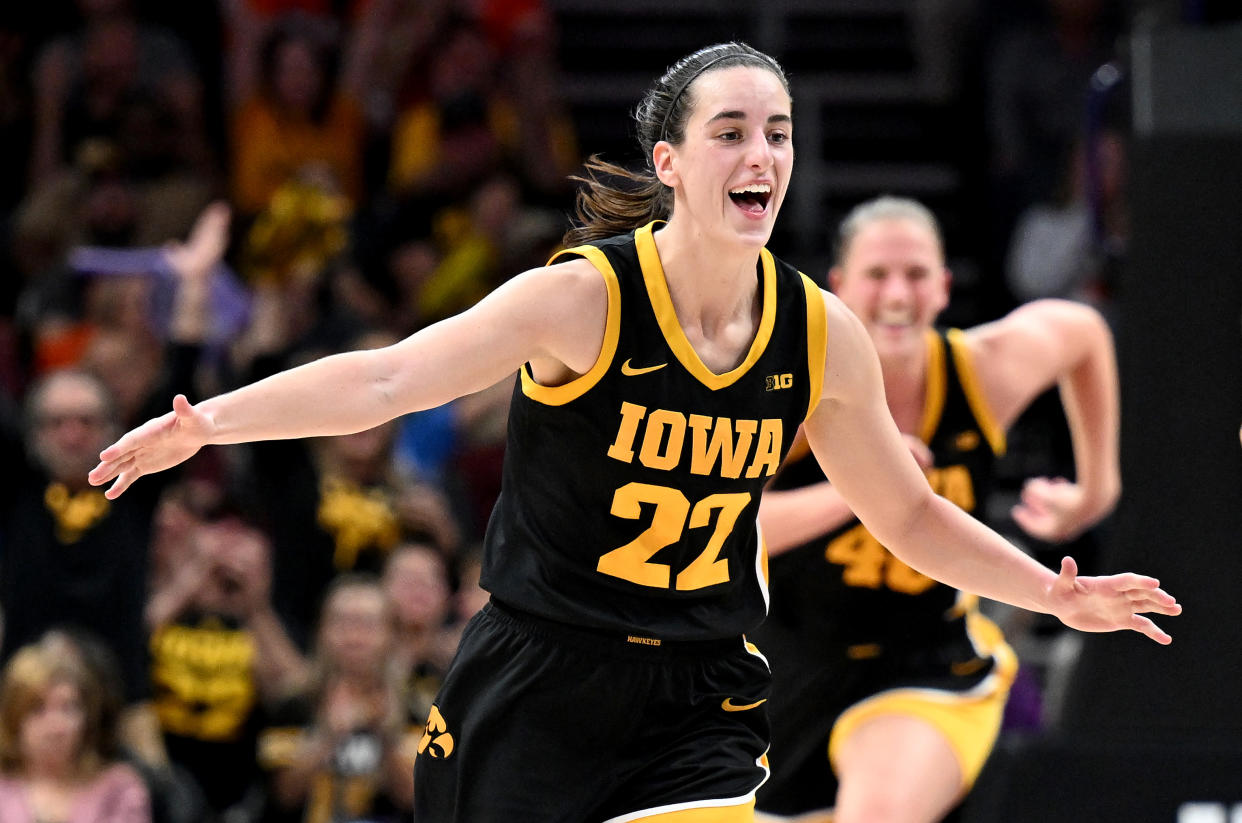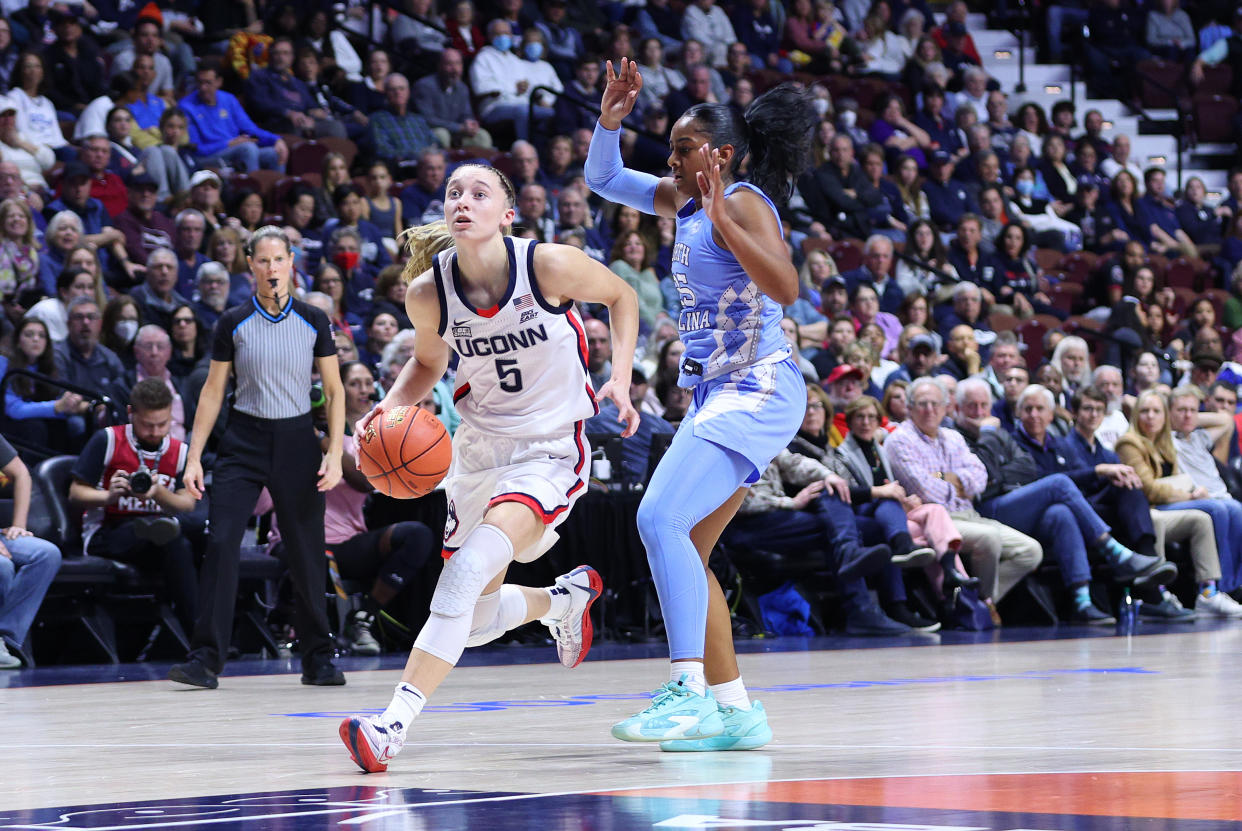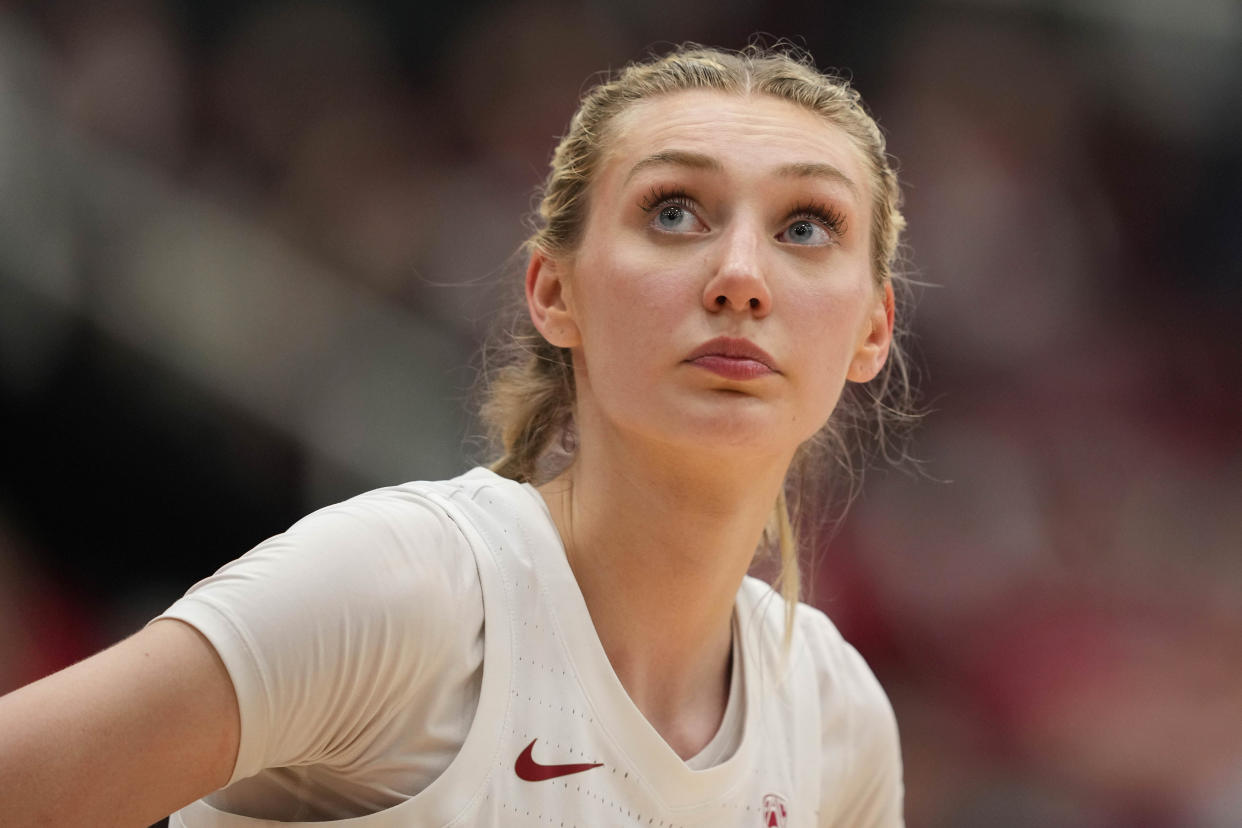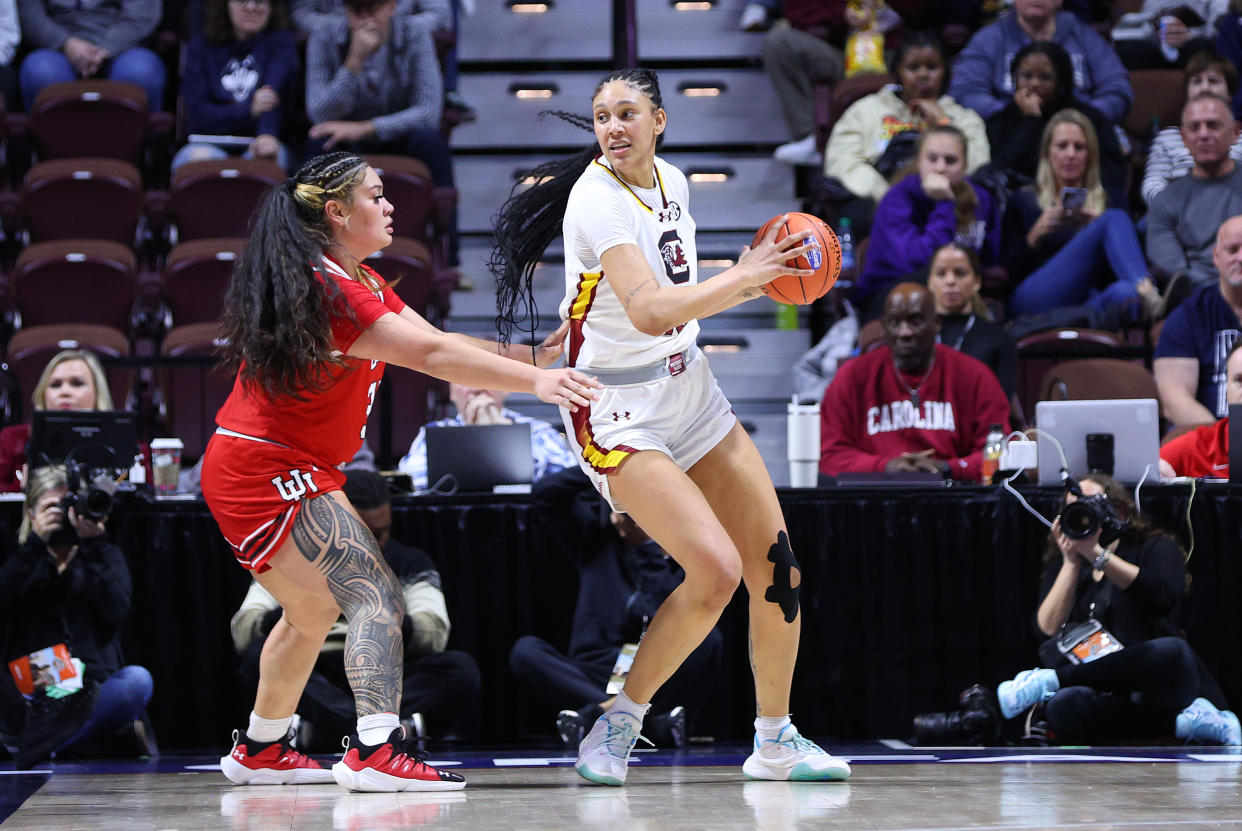2024 WNBA Mock Draft: Caitlin Clark to Fever at No. 1; Paige Bueckers, Cameron Brink also in lottery
With the best overall odds in the WNBA Draft Lottery coming into Sunday afternoon, the pingpong balls bounced in the favor of the Indiana Fever, a team that’s missed the postseason for seven straight years.
Indiana is the fifth franchise in league history to win the lottery in back-to-back years. The last time it happened, the Liberty opted to trade their top pick. Besides the Liberty, who were on the cusp of winning a championship this past fall, all the other teams who have drawn back-to-back Nos. 1 have followed them with championships.
However, we don’t know exactly who is coming out for the 2024 draft. Many of the prospects are still eligible to use their extra COVID-19 year, an exception given to NCAA athletes who played a winter sport during the 2020-21 season. This post-lottery mock draft includes all players who are eligible.

While Caitlin Clark and Paige Bueckers sit at the top of this draft class, the consensus strength lies in the group of forwards and centers who are eligible. The 2024 draft class is unique because of the many prospects who are dynamic guards capable of running a team at the point. Having players on rosters who can competently function at lead guard is currently at a premium in the W.
The 2024 class will feature at least four international prospects whom multiple talent evaluators believe will be drafted. While international players have been drafted over the years, such as Ezi Magbegor or Awak Kuier, there have been indicators more will be selected in higher rounds in 2024. Also, with a WNBA expansion draft looming, front offices see more value in draft-and-stash picks now than ever before. There’s an understanding that draft assets don’t have to get burned in training camp. These assets potentially yield a return.
Leading up to the draft lottery, Yahoo Sports spoke with multiple WNBA talent evaluators to get a sense of which foreign and domestic prospects were the most pro-ready.
Round 1
1. Indiana Fever: Caitlin Clark
Iowa senior guard
The Fever have been looking for a dynamic guard to pair with franchise hallmark Kelsey Mitchell for years. Now, they’ll finally get the chance. While Clark technically still has another year of eligibility, it’s hard to see her staying in college. However, if the Hawkeyes come up just short of a national championship in 2024, maybe Clark stays one more season.
Clark is a generational talent who can hit 3s from the logo, score at every level and is an exemplary facilitator. Her ability to pressure the rim and finish through contact has improved noticeably this season. WNBA talent evaluators noticed she’s made meaningful strides to improve her game.
While some talent evaluators believe Clark’s personality and character exude professionalism, there have been discussions about her understanding of how difficult the WNBA really is. How will she react when her shot isn’t falling? How will she adjust to not always being the No. 1 scoring option? “Everyone in the W is going to be wanting to humble her quickly,” one evaluator said.
2. Los Angeles Sparks: Paige Bueckers
UConn redshirt junior guard
When Fever general manager Lin Dunn was on the “Locked on Women’s Basketball” podcast, she explained amid all of the injuries and bad luck with health, it would be foolish to underestimate Bueckers: “She is the real deal.”
She can play both the one and the two, can score at all three levels and comes incredibly quickly off screens but also can create her own shot. While she’s been played off the ball and at the two guard much more this season, Bueckers’ instincts and ability to see what’s going to happen on the floor before it happens make her pro-ready.

Like Clark, Bueckers is an exceptional facilitator. Her defense has made some noticeable strides this season. But the concerns about Bueckers are how injury-prone she’s become and how much her body can react to the physical nature of the WNBA. One talent evaluator noted Bueckers needs to continue working on her body and get stronger. But also like Clark, Bueckers knows how to meet moments. She’s an entertainer and a dynamic offensive talent. It’s hard to forget what she accomplished at the 2021 Elite Eight when she led UConn to a Final Four following a double-overtime win over NC State.
It’s not certain Bueckers will decide to go pro next season, especially with her close friend, Azzi Fudd, sidelined for the season. But if she’s available, the Sparks, a team in need of better offensive players, will get to draft a special talent.
3. Phoenix Mercury: Cameron Brink
Stanford senior forward
Brink is the best two-way player in this class. She also can operate at many different spots on the floor. At 6-foot-4, she has a lot of guard skills. She’s able to handle the ball, pull up, shoot the 3 and pass. She’s made 96.3% of her free throws this season. She’s also been one of the most dominant posts in her senior season. She’s hit 62.5% of her 2s and has averaged 11.4 rebounds per game, eighth in the country. Defensively, she’s an excellent rim protector, fourth in the country in blocks with 3.3 per game.
The Mercury’s game in the post has been built around 33-year-old Brittney Griner. Choosing Brink, who plays the five and potentially the four, the most valuable position in the league, is going to bode the franchise well as it aims to reset under a new front office.

The concerns around Brink and her high ceiling are issues with fouling and her emotional maturity. “When she plays well, she’s really good,” one talent evaluator told Yahoo Sports. But there are questions surrounding what happens when she doesn’t play well and how quickly she’ll grasp the idea of what it means to be a pro.
4. Seattle Storm: Aaliyah Edwards
UConn senior forward
Edwards has a ton of pro-ready skills. She can finish through a lot of contact and has an established post-up and face-up game. She can guard the post and the perimeter and is incredibly switchable. She can hit a midrange jumper, similar to the way Griner can pop out and hit those in space. She is also a willing passer, something that's become a staple of UConn bigs.
In 2023, the Storm didn’t have a reliable post-scoring option at power forward. Magbegor’s natural position is the five, as is Mercedes Russell's. That left head coach Noelle Quinn to shift natural small forward Jordan Horston to the four.
5. Dallas Wings: Georgia Amoore
Virginia Tech senior guard
Amoore proved she could make a splash at the next level during her junior season. She took the women’s basketball world by storm with her prolific shooting during the ACC and NCAA tournaments. She plays well in the most pressing moments, a quality WNBA front office members value. She and Clark jockeyed for the record for most 3s in a single NCAA tournament.
While Amoore is a smaller point guard at 5-6, WNBA talent evaluators aren’t deterred. One talent evaluator remarked Amoore’s pro-ready “stocky” body is what will help her fend off the physicality immediately thrown at WNBA rookies. Executing the two-man game is a pro-ready skill another talent evaluator believes Amoore does at a higher level than most of the guards in this class.
“Her ability to hit the 3 off the pass, off the dribble, in the two-man game, you go under, she can stop and pop, her ability to get to the rim,” the evaluator said. “... I’m looking at all of these lead guards and she’s right at the top with her ability to execute the two-man game.”
6. Washington Mystics: Rickea Jackson
Tennessee fifth-year forward
Jackson really impressed WNBA coaches and GMs following her 15-point performance against Team USA on Nov. 5. She didn’t look intimidated and played her game. She’s an above average athlete who can create her own shot inside 17 feet, something the Mystics desperately need. The Mystics had the seventh-best offense and at times struggled when an offensive set was junked or they weren’t running in transition. While Jackson isn’t the prolific defender Shakira Austin is, she’s not a liability on defense. She has the skills to defend well one-on-one.
Also, the Mystics’ situation with power forward Elena Delle Donne is anything but certain. There are questions on whether she comes back and how long she can play after myriad injuries. The Mystics could use a power forward of the future, especially when Myisha Hines-Allen might not be the player Washington thought she was.
7. Minnesota Lynx: Kamilla Cardoso
South Carolina senior center
Throughout a lot of 2023, the Lynx were undersized and outmuscled in the post. Often they relied on 6-5 Dorka Juhász to go up against the Brittney Griners and Jonquel Joneses of the league. While Cardoso will be just as green as Juhász was in her rookie season, she’s two inches taller and has shown she has the potential to develop into an impactful rim protector. Cardoso is fifth in the country in blocks per game with 3.1.

Head coach Cheryl Reeve loves posts who can rebound the ball. She’s been craving an excellent rebounder ever since Rebekkah Brunson retired in 2018. Cardoso is 15th in the country in rebounding, pulling down 10.9 per game. A question about Cardoso is how she will adapt to playing against posts who are either her size or even taller. The learning curve for bigs in the WNBA is steeper than for guards.
8. Atlanta Dream: Nyadiew Puoch
Australia, forward
The Dream had an excellent transition offense, but struggled defending in transition. What Puoch possesses besides having pro experience in Australia’s Women’s National Basketball League is how well she can survey the floor defensively and provide help when necessary. She defends in space really well. She’s been called “one of the best transition defenders in the world” at her age. With a 6-5 wingspan to accompany her 6-3 height, she’s been able to hit 3s in the corner. Her offensive skill set remains a work in progress. While Puoch has been called “Baby Ezi,” by some WNBA talent evaluators, some also believe she’s very raw and might not be ready to come over and compete in the W yet. But even if general manager Dan Padover and the Dream determine she isn’t ready yet, they are more than comfortable with drafting and stashing the 19-year-old.
9. Dallas Wings: Charisma Osborne
UCLA grad guard
Dallas was the worst 3-point shooting team in the WNBA last season (31.7%). The Wings don’t need bigs. They need guard play that can open up the floor for their big contingent of Teaira McCowan, Natasha Howard, Satou Sabally, Kuier and Maddy Siegrist.
Osborne will look favorable to the Wings not only because of her greatly improved 3-point shooting — 44.6% this season on over six attempts per game — but also because she’s used to sharing the floor and operating alongside a true back-to-the-basket dominant post in Lauren Betts. While Osborne is a more natural two guard than a one guard, what will earn her time on the floor is her ability to shoot and distribute coupled with her above-average perimeter defense.
10. Connecticut Sun: Jacy Sheldon
Ohio State grad guard
Sheldon is a capable scorer at all three levels and can lead an offense. She’s a combo guard who possesses lead guard-level instincts and has success playing on and off the ball. She’s an efficient slasher and is incredibly crafty picking her spots around the rim. While there were concerns about how reliably she could hit a 3, nine games into the 2023-24 season, Sheldon is hitting 40.5% of her 3s while averaging just over four attempts this season. That’s the highest percentage of her college career.
Similarly to questions about how Bueckers’ body can take pro-level contact, the same concern is at play for Sheldon. She has a very lean frame. While her one-on-one defense might need some work, one talent evaluator sees her desire and effort playing defense in Ohio State’s full-court zone press that flows into a man-to-man style defense as a sign she has the tools that can catapult her to having a two-way skill set.
11. New York Liberty: Leïla Lacan
France, guard
The Liberty aren’t shy about drafting and signing French prospects. In addition to Marine Johannès, who New York didn’t technically draft, the Liberty drafted 20-year-old Marine Fauthoux in the third round in 2021. New York will also be looking for athletic guard play across this draft. Lacan has excellent size at the guard spot at about 5-11, and her athleticism allows her to put pressure on the rim and constantly draw fouls. The question for Lacan will be how much she can work on and reliably hit her 3-point shot in order to be able to make a greater impact at the WNBA level.
12. Los Angeles Sparks: Te-Hina Paopao
South Carolina senior guard
Transitioning from the Pac-12 to the SEC isn’t easy and WNBA scouts have been impressed with how Paopao has done. Her leadership has also transferred seamlessly, earning the trust of a new team quickly. What’s also impressive is how she’s been shooting the most efficiently of her career. After eight games and 75 shots attempted, she has shot 50% from 2-point range (16-of-31) and 51.2% from 3-point range (22-of-43).
The Sparks are in desperate need of more shooting and offensive prowess. While they were without Lexie Brown for the majority of the 2023 season, LA had the second-worst field-goal percentage in the league (42.5%). But there is some concern from one WNBA talent evaluator about her lateral movement, especially on the defensive end. GMs and coaches value players who show potential to either play or guard multiple positions. This evaluator believes Paopao has some ways to go.
Round 2
13. Chicago Sky: Angel Reese
LSU junior forward
As of now, this is the only pick the Sky have in the draft, and they could make a splash with it. A lot of teams could pass on Reese after the drama that ensued at LSU this fall, but Chicago will be drawn to Reese’s defensive tenacity and her ability to pursue the basketball on the boards.
One WNBA talent evaluator compared her to a smaller version of 2022 third overall pick Shakira Austin; Reese’s strengths are mostly on the defensive end, but she has a long way to go on the offensive end. Another talent evaluator believes there’s a lot of work to be done on her game, but also on her maturity. “I think someone will take a chance because it’s her and Caitlin Clark that are bringing in those fans,” the evaluator said.

14. Seattle Storm: Celeste Taylor
Ohio State grad guard
Taylor is probably the second-best defender in the 2024 draft class. Evaluators believe she can hold her own guarding players from positions 1-3. While she has the potential to turn into a serviceable 3-and-D prospect, her splits shooting from 3 (20.7% on 3.2 attempts per game) hasn’t proven she’s there yet.
15. Indiana Fever: Aubrey Griffin
UConn senior guard/forward
Griffin is a rare do-it-all wing in this class. While that alone won’t guarantee she’ll be drafted, evaluators believe she has a pro-ready body and athleticism, can defend multiple positions and are impressed with her rebounding ability at 6-1 and her ability to make others around her better.
16. Las Vegas Aces: Hailey Van Lith
LSU senior guard
Van Lith is being challenged by LSU head coach Kim Mulkey to play the point, and WNBA talent evaluators noticed she looks like a fish out of water. She’s not a great operator in the two-man game and doesn’t always make the most instinctual pass. She has been called a more natural two guard who thrives off ball and can score at all three levels. Her challenge across her college career has also been efficiency, and it won’t get any easier at the pro level. One talent evaluator doesn’t think Van Lith will be able to get off her midrange pull-up that she’s been able to in college at the next level. While there are a lot of question marks about Van Lith, multiple talent evaluators pointed toward her work ethic that will give her an opportunity to show WNBA teams what she can do. Van Lith was a participant in Kelsey Plum’s Dawg Class, a course designed to prepare college players for the WNBA.
17. New York Liberty: Charlisse Leger-Walker
Washington State senior guard
Leger-Walker burst onto the scene when she led Washington State to its first Pac-12 championship last fall. As the tournament’s most outstanding player, she averaged 16.3 points and 7.3 rebounds per game. But this past fall Leger-Walker has proven she’s a playmaker, too. She racked up her first career triple-double (11 points, 15 rebounds and 13 assists) last month when the Cougars beat Maryland.
18. Las Vegas Aces: Alissa Pili
Utah senior forward
Pili’s 37-point outburst on 65.25% shooting against South Carolina and Cardoso put the country on notice. Her efficiency not only in the paint but from 3 raised some eyebrows. Pili is an intriguing, but also a confusing prospect. While she’s undersized at 6-2, she is incredibly strong and can shoot the 3 at a high clip. It’s hard for talent evaluators to know right now how Pili’s game can translate to the pros. Is she a four or a five?
19. Minnesota Lynx: Nika Mühl
UConn senior guard
While Mühl’s assist and steal averages are down early in her senior season, her skill set is still valuable for teams at the next level. She’s been less aggressive taking open 3s and looking for her own shot. Talent evaluators see that as part of her process of adjusting to sharing the floor again with Bueckers. Many WNBA teams could use a player who could grow into a career backup lead guard, and Mühl has the size, defensive toughness and experience running a team that could help fill that need.
20. Atlanta Dream: Isobel Borlase
Australia, guard
What’s appealing about Borlase is her experience playing against WNBA-level pros at 19 years old. That gives her a bit of a one-up on college players who aren’t used to the speed and physicality at the next level. While Liberty head coach Sandy Brondello prognosticated Borlace will get drafted in the first round, there are questions about whether she can evolve into more than a spot-up shooter who can finish at the rim. As the youngest player in this draft class at 19, she has a lot of room to grow.
21. Washington Mystics: Kaitlyn Chen
Princeton senior guard
General manager Mike Thibault is known for taking a chance on intriguing mid-major prospects. The Mystics could use a backup point guard. What’s encouraging about Chen is she’s hit 38.1% of her 3s on 21 attempts, a step up from the 26.5% clip she had last season.
22. Connecticut Sun: Ayoka Lee
Kansas State senior center
What talent evaluators like about Lee is her size at 6-6, and while true back-to-the-basket centers are rare in the WNBA, they still have a place in the league. (See Griner, McCowan and Aliyah Boston.) While one evaluator has noticed Lee’s still icing her surgically repaired knee once she leaves the floor for the bench, teams that need size like the Sun could take a look at her during training camp.
23. New York Liberty: Carla Leite
France, guard
While Leite has a smaller upside than Lacan, Leite has a knack for getting downhill and reading drop coverages really well. A concern is how she plays off the ball and making sure she’s engaged without the ball in her hands.
24. Las Vegas Aces: Hannah Jump
Stanford grad guard
Head coach Becky Hammon looks for players who can shoot, and that’s certainly what Jump can do. Across her five seasons at Stanford, she’s averaged above 38% shooting from 3. The Aces were missing a really proficient three-shooter coming off the bench following Riquna Williams’ injury and subsequent arrest during the 2023 season. Jump’s lightning-quick release, coupled with her ability to shoot efficiently off the catch and dribble, should give her an opportunity at the next level.
